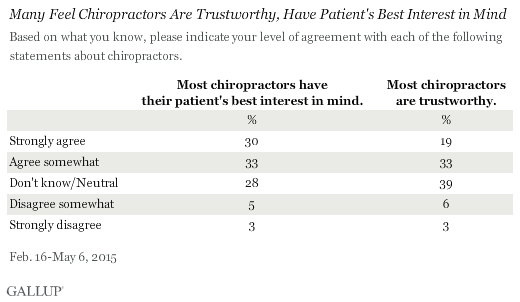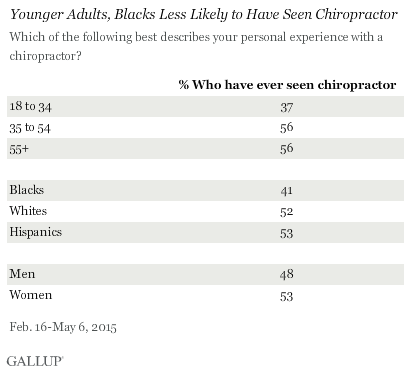Story Highlights
- Two-thirds say chiropractic effective for neck, back pain
- Many adults say chiropractors think of patient's best interest
- More than 33 million U.S. adults saw a chiropractor last year
WASHINGTON, D.C. -- Chiropractic care has a positive reputation among many U.S. adults for effective treatment of neck and back pain, with about six in 10 adults either strongly agreeing (23%) or agreeing somewhat (38%) that chiropractors are effective at treating these types of pain.

These findings come from the first-ever nationally representative annual survey of U.S. adults measuring perceptions of and experiences with chiropractic care. Chiropractic care focuses on neurological and musculoskeletal health, and aims to favorably affect overall health and well-being, relieve pain and infirmity, enhance performance, and improve quality of life without drugs or surgery. Palmer College of Chiropractic, the founding and largest college of chiropractic in the world, commissioned Gallup to design and conduct this study of 5,442 adults, aged 18 and older, in the U.S.
Many Adults Say Chiropractors Have Their Patient's Best Interest in Mind
Many adults in the U.S. have positive perceptions of chiropractors. Nearly two-thirds of U.S. adults either strongly agree (30%) or agree somewhat (33%) that most chiropractors have their patient's best interest in mind. Slightly more than half of U.S. adults also agree that most chiropractors are trustworthy. Less than 10% disagree with either of these statements.

About Half of U.S. Adults Have Seen a Chiropractor
Half of adults in the U.S. have had some experience as a patient of a chiropractor, including 14% of respondents -- or an estimated 33 ½ million U.S. adults -- in the 12 months prior to the study. These recent users of chiropractic visited a chiropractor an average of 11 times during that time period. An additional 12% of respondents -- an estimated 29 million U.S. adults -- say they saw a chiropractor in the last five years, but not in the past 12 months. Together, Gallup estimates that 63 million adults in the U.S. have seen a chiropractor in the last five years. One in four adults last saw a chiropractor more than five years ago, and nearly half (49%) have never seen a chiropractor.

Chiropractic use is not isolated to certain types of people living in the U.S. Adults who have been to a chiropractor in the last five years span the age spectrum and come from different racial, educational and socio-economic backgrounds.
While there are not many demographic differences among recent users of chiropractic care, there are notable differences among people who have visited a chiropractor before and those who have not.
Adults aged 35 and older (56%) are more likely than younger adults (37%) to report that they have been to a chiropractor. Blacks are less likely than whites or Hispanics to report having seen a chiropractor. Also, men are slightly less likely than women to say they have ever seen a chiropractor.

Chiropractic Preferred for Back, Neck Pain Over Massage, Physical Therapy
When given a choice of five different healthcare providers they might see about neck and back pain, regardless of cost, slightly more than half of adults (54%) say a medical doctor would be their first choice, followed by 29% saying they would most like to see a chiropractor. Less than 10% would prefer to see a physical therapist, massage therapist or acupuncturist for neck or back pain.

Bottom Line
Most Americans believe chiropractic is an effective way to treat back and neck pain. More than 33 million adults in the U.S. have seen a chiropractor in the last 12 months, and twice as many say a chiropractor would be their first choice to see for neck or back pain if they had it. With the National Institute of Arthritis and Musculoskeletal and Skin Diseases estimating that eight out of 10 people will suffer from back pain at some point in their lives, the chiropractic industry could be poised for considerable growth in the future.
Read the full report.
Survey Methods
Results are based on a Gallup Panel study of 5,442 national adults, aged 18 and older, conducted Feb. 16-May 6, 2015, via the Web and by mail. The Gallup Panel is a probability-based longitudinal panel of U.S. adults whom Gallup selects using random-digit-dial phone interviews that cover landline and cellphone users. Gallup also uses address-based sampling methods to recruit Panel members.
The Gallup Panel is not an opt-in panel, and members do not receive incentives for participation. Using 2012 Current Population Survey figures, researchers weighted the sample for this study to be demographically representative of the U.S. adult population. For results based on this sample, one can say that the margin of sampling error is ±2 percentage points at the 95% confidence level. Margins of error are higher for subsamples. In addition to sampling error, question wording and practical difficulties in conducting surveys can introduce error and bias into the findings of public opinion polls.
Learn more about how the Gallup Panel works.
